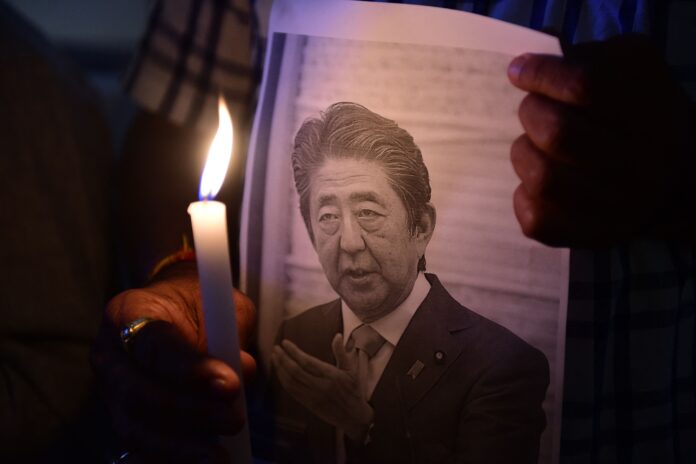Bodyguards could have saved Shinzo Abe if they shielded him or removed him from the line of fire in the 2.5 seconds between a missed first shot and a second round of gunfire that fatally wounded him, according to eight security experts who reviewed footage of the former Japanese leader’s assassination.
The failure to protect Abe from the second shot followed what appeared to be a series of security lapses in the lead-up to the assassination of Japan’s longest-serving prime minister on July 8, the Japanese and international experts said.
Abe’s killing in the western city of Nara by a man using a homemade weapon shocked a nation where gun violence is rare and politicians campaign up close to the public with light security.
Japanese authorities— including Prime Minister Fumio Kishida — have acknowledged security lapses, and police say they are investigating.
In addition to the security experts, Reuters spoke to six witnesses at the scene and examined multiple videos available online, taken from different angles, to piece together a detailed account of security measures ahead of his shooting.
After leaving 67-year-old Abe exposed from behind as he spoke on a traffic island on a public road, his security detail allowed the shooter — identified by police as Tetsuya Yamagami, 41 — to come within meters of Abe unchecked, carrying a weapon, the footage showed.
“They should have seen the attacker very deliberately walking towards the rear of the prime minister and intervened,” said Kenneth Bombace, head of Global Threat Solutions, which provided security to Joe Biden when he was a presidential candidate.
Yamagami came within around 7 meters of Abe before firing his first shot, which missed, the Yomiuri newspaper said, citing investigative sources. He fired the second shot, which hit, at around 5 meters away, it said.
Abe’s bodyguards did not appear to have “concentric rings of security” around him, said John Soltys, a former Navy SEAL and CIA officer now a vice president at security firm Prosegur. “They didn’t have any kind of surveillance in the crowd.”
Asked about the experts’ analysis, the Nara Prefectural Police, in charge of security for Abe’s campaign stop, told Reuters in a statement the department was “committed to thoroughly identifying the security problems” with Abe’s protection, declining to comment further.
World reacts to assassination of former Japanese PM Shinzo Abe – Jul 8, 2022
The video footage showed that, after the first shot, Abe turns and looks over his left shoulder. Two bodyguards scramble to get between him and the shooter, one hoisting a slim black bag. Two others head toward the shooter, who moves closer through the smoke.
Trending Stories
Joe Rogan says Canada is ‘communist,’ calls Justin Trudeau a ‘sketchy guy’
Pizza delivery man hailed as hero after rescuing 2 kids, 3 teens from house fire
Although Abe’s security tackled the assailant moments later and arrested him, it was the “wrong response” for some of the security to go after the shooter instead of moving to protect Abe, said Mitsuru Fukuda, a Nihon University professor specializing in crisis management and terrorism.
There was enough security, “but no sense of danger,” said Yasuhiro Sasaki, a retired police officer in Saitama prefecture near Tokyo who handled security for VIPs. “Everyone was startled and no one went to where Abe was.”
The Tokyo police, in charge of VIP politicians’ bodyguards, referred questions to the Nara police.
The National Police Agency, which oversees local police forces, said Abe’s killing was the result of the police failing to fulfill their responsibility and said it had set up a team to review security and protection measures and to consider concrete steps to prevent such a serious incident from recurring.
“We recognize that there were problems not only in the on-site response, such as the security and protection set-up, deployment of personnel and fundamental security procedures, but also in the way the National Police Agency was involved,” it said in response to Reuters questions.
Reuters could not reach Yamagami, who remains in police custody, for comment and could not determine whether he had a lawyer.
Footage shows four bodyguards inside the guardrails as Abe spoke, according to Koichi Ito, a former sergeant at the Tokyo Metropolitan Police Department’s special assault team, now a security consultant. Their number was corroborated by local politician Masahiro Okuni, who was at the scene.
When the former prime minister stepped up to speak, Yamagami could be seen in video footage in the background, clapping.
As Yamagami walked up behind Abe, security did not appear to take action, the footage showed.
Abe should have had a dedicated close protection bodyguard to get him away, said a member of the U.S. Diplomatic Security Service, which protects senior diplomats and foreign dignitaries.
“We would grab him by the belt and collar, shield him with our body and move away,” the agent said.
Katsuhiko Ikeda, former superintendent general of the Tokyo police who ran security for Japan’s Group of Eight summits in 2000 and 2008, said the situation would have developed very differently if Abe’s security detail had been close enough to reach him in a second or two.
Ito, the former police sergeant, said security could have stopped the first shot had they been vigilant and communicating.
“Even if they missed that, there was a more than two-second window before the second shot, so they definitely could have prevented that,” he said. “If Abe had been protected properly, it could have been avoided.”
(Reporting by Satoshi Sugiyama in Nara, Sam Nussey in Tokyo and Ju-min Park in Seoul; Additional reporting by Tim Kelly, Rocky Swift, Kiyoshi Takenaka, Nobuhiro Kubo, David Dolan and Yukiko Toyoda; Writing by Sam Nussey; Editing by David Dolan and William Mallard)
© 2022 Reuters



